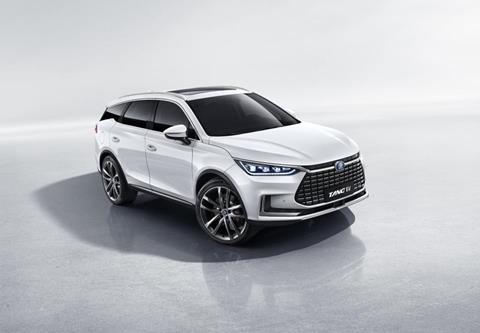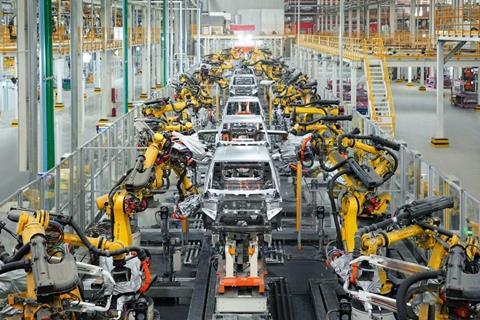In this new monthly column, Ian Henry of AutoAnalysis looks at a major automotive development and places this within its broader context, asking what this means for the industry. To kick this series off, Ian looks at BYD (Build Your Dreams), the Chinese company which – if it succeeds – will be a major player in Europe within the next few years; it is already the largest EV manufacturer in the world

Currently, barely a week goes by without news on BYD, which is now leading the EV sales charts, selling over 3m EVs in 2023, well ahead of Tesla’s 2.1m. In mid-January it was announced as the “Official Partner” of UEFA’s Euro 2024 football competition; this follows confirmation that it will build a car and battery plant at Szeged in Hungary to take advantage of its (admittedly slowly) growing position in Europe. The Hungarian plant will make both EVs and PHEV models. It has had an electric bus plant in the country for some years but opening a European car plant gives it an air of permanence in the evolving structure of the industry. No definite information has emerged on the size of this plant, but capacity of at least 150,000 is likely, with the potential to raise this. BYD has also been present in the UK for some years via a technology licensing arrangement with Scottish bus maker, Alexander Dennis which produces around 1,000 buses a year using BYD technology.
Leveraging the cost advantage
Meanwhile, the European Commission has announced an investigation into Chinese EV manufacturers, to assess whether they receive unfair advantages and subsidies from the Chinese government. Whether BYD’s decision to open a European car plant has been brought forward or influenced by this investigation is open to debate; it seems likely that the possibility that the Commission could raise additional tariffs on Chinese-made EVs imported to Europe will have been in the company’s thoughts (Chinese car imports to the EU and the UK, whether ICE, PHEV or battery powered are subject to a 10% tariff as a matter of course, but this could rise following the Commission’s investigation). Intriguingly, press reports have cited estimates from UBS which suggested that – even if BYD switched production to Europe to avoid tariffs – it would still have a 25% cost advantage over incumbent European manufacturers. If this is true, then more than one European BYD factory could be expected in the years ahead.
BYD already exports from China to more than 70 countries, with exports accounting for just over 240,000 units (c8% of sales) in 2023. It has opened a showroom in the centre of London, on Berkeley Street, taking over a premium site formerly occupied by JLR. This symbolic move, along with its other international steps, is part of the plan set out by its founder, Wang Chuanfu, to dominate the industry and overtake legacy Western brands. BYD wants a 10% share of the European car market by the end of the 2020s, equivalent to c1m units in the EU which would be a remarkable achievement for a company with less than 20,000 EU sales in 2023.
Benefitting from vertical integration
BYD differs from most Western car companies with a high level of vertical integration, making semi-conductors, LEDs, lighting, batteries, transmission, axles, PHEV systems; these parts, as well as thermal management systems, wiring harnesses, cockpits, ADAS systems, passive safety systems, brakes, suspensions, exhaust, steering and body control modules, are all made by its wholly owned subsidiary FinDreams Technology. BYD’s vertical integration also includes logistics. It has recently launched its first car transport ship of its own, with 7,000 cars now on the way to Europe; more ships are in order as the company looks to reduce dependency on shipping companies.
Certainly, BYD has a much higher level of vertical integration than any European VM, higher even than the Korean or Japanese companies with their chaebol or keiretsu companies. It also owns stakes in several battery materials companies, including mines. BYD has secure materials supply chains and in January it was reported to have begun talks about a takeover of a Brazilian lithium producer, Sigma Lithium, the owner of a mine and processing plant in Minas Gerais state, north of Rio de Janeiro. This news coincided with BYD building its first EV factory outside Asia, in Brazil; a factory in Mexico is also understood to be under consideration. This news comes on the heels of reports in 2022 that BYD had acquired ownership of – or the exclusive use of – six mines in Africa, although these reports have not been confirmed.

Rapid business development
BYD’s origins lie in producing batteries for the burgeoning mobile phone market in the mid-1990s and by 2005 it reportedly had more than half of the global market in mobile phone batteries; this brought it to the attention of the veteran US investor Warren Buffett, who rarely backs a loser. He acquired a 9.8% stake in the company in 2008 which he retains today.
BYD moved into automotive manufacturing in 2003 with the acquisition of Shaanxi Qinchuan, at the time one of 28 car companies manufacturing in China. At this point, moreover, entry into the auto sector was only allowed through acquisition, as the government feared oversupply if it allowed uncontrolled new entrants. Shaanxi was not in good financial shape at the time of the acquisition, and BYD did not produce a vehicle under its own name until 2005 after a period of reorganisation of Shaanxi. The first BYD car was a petrol engine model and was followed by a PHEV in 2008 and an EV, named e6, in 2009. Pure ICE vehicle production ended in 2022, although PHEV production remains.
In a little over a decade, BYD has brought its owners dream to life; once a minnow, it is now the leading EV manufacturer in the world. By the end of the 2020s, we can expect to see major BYD plants in Europe, Brazil and probably Mexico. It may face objections to its rapid growth from the US, but it is difficult to see European authorities stymieing its growth once its factory in Hungary is up and running; given the speed at which it has grown at home, a second factory in Europe would not be a surprise. Legacy manufacturers may not like it, but the Chinese “invasion” is following the first two waves of Asian investors, namely the Japanese and Koreans. The re-election of Donald Trump may lead to blocks on further Chinese investment in the US but in Europe, the authorities and national governments would far rather have the investment on the ground, generating local jobs, than have increased imports: far better to bring the newcomers inside the tent than have them sniping from the outside.
More news, more investment
Further news has emerged on BYD confirming its growing significance and ambitions. First, the company announced long term investment of 100billion yuan (US$14billion) in smart car features, although it did not give much detail on the new technologies, nor a timeframe for their introduction. One feature already available and expected to see widespread roll-out will be “Navigation on Autopilot” which allows drivers to take their hands of the steering wheel briefly, with drivers still required to touch the wheel every 15 seconds. Another advanced technology feature will come on the Yangwang U8 SUV which will have a vehicle mounted drone and a detachable steering wheel which will allow drivers to use this, with the car’s pedals, to play video games (presumably when the car is stationary).
The U8 SUV and a smaller model, the Bao 5, will be launched in Europe during 2024; the U8 will be positioned as a fully electric competitor to the Land Rover Defender. Whether these will be sold under the same brand names – Yangwang and Fan Cheng – as in China or whether they will get more international sounding brands is an interesting question.
And finally (for now), BYD has announced expansion into Indonesia, increasing its fledging dealership network from seven to 50 during 2024 and committing to investing cUS$1.3billion in a 150,000 units per year capacity factory in the country, to make EVs.
These technology and market developments confirm BYD’s intentions of maintaining its domestic and growing international presence, the broader challenges of the EV market’s development notwithstanding.






































No comments yet